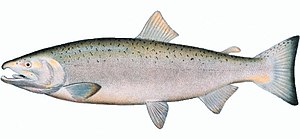
Image via Wikipedia
Environment Fishery Science
Salmon have extra large guts–up to three times larger than its body would suggest–that help it survive, scientists at the University of Washington say.
The study “Excess digestive capacity in predators reflects a life of feast and famine” is published in Nature.
A news release from the university calls the large gut a “previously unrecognized survival tactic.” Although fishers who gut a salmon may say that no one noticed how big the gut actually was as they threw it away, the same apparently applied to scientists as the article states: “Despite …basic principle of quantitative evolutionary design, estimates of digestive load capacity ratios in wild animals are virtually non-existent.”
The study is by PhD student Jonathan “Jonny” Armstrong, originally from Ashland, Ore, who says he has been fascinated by salmon ever since he saw a Chinook leap out of the water when he was ten.
The study says that when the “foraging opportunities for animals are unpredictable, which should favour animals that maintain a capacity for food-processing that exceeds average levels of consumption (loads), The study that piscine [fish] predators typically maintain the physiological capacity to feed at daily rates two to three times higher than what they experience on average…”
“This much excess capacity suggests predator-prey encounters are far patchier – or random – than assumed in biology and that binge-feeding enables predators to survive despite regular periods of famine,” Armstrong said. Co-author and supervisor on the paper is Daniel Schindler, University of Washington professor of aquatic and fishery sciences.
“Guts are really expensive organs in terms of metabolism,” Armstrong said. For instance, maintaining a gut can require 30 to 40 per cent of the blood pumped by an animal’s heart.
Some animals have some capacity to grow or shrink their guts in response to changing conditions. For example, according to previous studies, the digestive organs of birds that are about to migrate expand so they can eat more and fatten up. This is followed by a period when their guts atrophy and then, freed of the baggage of heavy guts, the birds take off. But this study shows that many fish species maintain a huge gut, which enables them to capitalize on unpredictable pulses of food.
Ravens and crows, for example, are known to cache food far from where they find it. Fish can’t do that. “Unlike some other animals, fish can’t just hoard their food behind a rock in the stream and eat it later. They need to binge during the good times so that they can grow and build energy reserves to survive the bad times,” Armstrong says.
Armstrong is part of the university’s School of Aquatic and Fishery Sciences which has a field site at the Alaska Salmon Program’s Lake Aleknagik. Using a dry suit, Armstrong snorkeled the Aleknagik tributaries, swimming in waters as low as 5°C where he found out the Aleknagik streams exhibited tremendous variation in water temperature, which inspired him to study how those temperatures affected the ecology of the streams.
In his initial studies, he looked at the effect of water temperature on juvenile coho’s ability to consume sockeye eggs. He says, “In cold streams, juvenile coho salmon were too small to fit the abundant sockeye eggs in their mouths. In warmer streams, the coho grew large enough to consume eggs, gorged themselves, and achieved rapid growth, and this suggested that small changes in temperature can have disproportionate affects on coho salmon production.”
The “previously unrecognized survival tactic” might apply to other top predators, such as wolves, lions and bears, Armstrong says.
